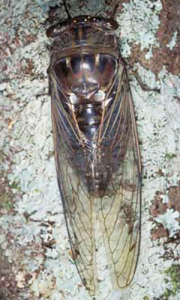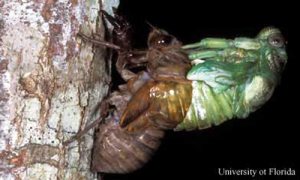You may recognize the arrival of summer because of the intense buzzing sound coming from the trees. It can last all day long, with changes in the pitch and pattern of the screaming.

Dusk-calling cicada, Tibicen auletes (Germar). Total length (head to tips of forewings) is 64 mm (about 2 1/2 inches). Photograph by Lyle J. Buss, University of Florida.
Cicadas are large (3/4” – 2 ½”) winged insects with stocky bodies and bulging eyes. They spend the vast majority of their lives underground, emerging in massive numbers for just a few weeks to mate and lay eggs. This behavior often earns them the name “locusts,” which entomologically they are not.
In much of the eastern United States, periodical cicada (Magicicada spp.) broods rise up out of the ground every 13 or 17 years. In the summer of 2024, two different broods (one group of 13-year cicadas and one group of 17-year cicadas) will arrive at the same time across 16 states. The closest to us will be mid-lower Alabama. Approximately one trillion insects are anticipated. This only happens once every 221 years.
By emerging in large numbers, the cicadas are able to reduce the potential of being eaten by predators. Though many will be lost to birds and killer wasps, enough will survive to be able to reproduce.
Unlike the broods of periodical cicadas, populations of Florida’s 19 cicada species produce adults every year. However, the nymphs still spend several years developing underground. The nymphs use their piercing-sucking mouthparts to feed on the xylem sap in the roots of trees. The feeding can weaken already stressed trees. Most trees tolerate the damage quite well. After gaining enough nutrients, the nymphs wait for the soil to warm enough (approximately 64° F. at six inches deep) before crawling out of the ground, climbing up the tree trunk, and molting into adults with wings. You can often find the empty shed exoskeleton still hanging on the tree trunk.
The adult male spends all day being as loud as possible in order to attract the girls. Each species has its own song. Large numbers of insects create more noise. Male cicadas have a pair of tymbals located on the sides of their abdomen. Tymbals are corrugated regions of the cicada’s exoskeleton that can be vibrated so rapidly that the clicking sound becomes a high-pitched buzz. Cicadas with the best abs get the girls and reminds all the humans that summer is here.
To learn more about cicadas and train your ears to the different species call go to: https://entnemdept.ufl.edu/creatures/misc/bugs/cicadas.htm

Cicada (Tibicen sp.) escaping its nymphal skeleton. The cast skeleton will remain attached to the tree. Once free, the adult will expand its wings, darken, and fly away. Photograph by Lyle J. Buss, University of Florida.
- Watch for “Melting Grass” - February 19, 2025
- Palms Can Suffer in the Cold - January 30, 2025
- Camellia Care - January 9, 2025
